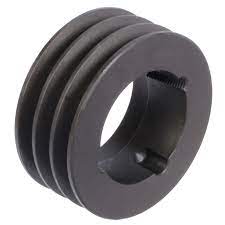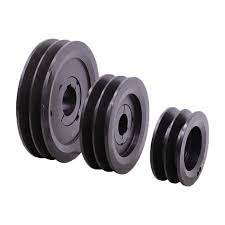Product Description
Timing Belt Pulley Price cast Iron Transmission Machine Parts Manufacture Best Sale Tensioner Cutter SPA/06 Aluminum European Standard Durable Timing Pulleys
In power transmission, belts are flexible loops of material that can link 2 rotating shafts mechanically and transmit power between them. Belts are also the primary component in belt drives, where 1 or more continuous belts are fitted over 2 pulleys at 2 shafts and rotary motion is transferred from the driving pulley to the driven pulley.
As compared to chain drives and gear drives, belt drives run quietly and smoothly and do not need lubrication. Maintenance is also comparatively convenient, and the driven shaft speed can be easily altered by changing pulley sizes.
The most common types of belts are V-belts and timing belts. V-belts are the most common type of belt today, and as their name suggests, their cross-sectional shape comes in the form of a “V”. Generally endless, the “V” cross-sections of these belts lodge in the mating grooves of their corresponding V-belt pulleys, preventing slipping due to under-10sioning. In general, V-belts require less width and tension compared to flat belts.
Timing belts are toothed belts that enable positive drive. They have rows of interlocking teeth that fit securely with a toothed pulley to avoid slipping. Timing belts require less tension than other belts, have no slippage, and do not require lubrication, however their power capacity is lower than V-belts and chains. They are frequently used in camshafts of automobiles and crankshafts.
| Manufacturing Process: | Forging |
|---|---|
| Material: | Aluminum |
| Surface Treatment: | Oxygenation |
| Transport Package: | Wooden Case |
| Trademark: | EPT |
| Origin: | Zhejiang China |
| Samples: |
US$ 9999/Piece
1 Piece(Min.Order) | |
|---|

How do you select the right spa pulley for a specific spa model and purpose?
Selecting the right spa pulley for a specific spa model and purpose involves considering several factors. Here’s a detailed explanation of the steps involved in choosing the appropriate spa pulley:
1. Identify the Spa Model:
Begin by identifying the specific make and model of the spa for which you need the pulley. Different spa models may have varying requirements in terms of power transmission, belt type, and pulley configuration. Consult the spa manufacturer’s documentation, specifications, or contact their customer support to gather information about the recommended pulley specifications for your spa model.
2. Determine the Purpose:
Next, determine the purpose of the pulley within the spa system. Are you selecting a pulley for a pump, blower, control system, filtration system, or another component? Understanding the purpose will help you narrow down the specific requirements and characteristics needed for the pulley.
3. Consider Power Requirements:
Consider the power requirements of the component the pulley will drive. This includes factors such as the motor power rating, desired speed, and torque. Ensure that the pulley you choose is capable of handling the power demands of the specific spa equipment.
4. Evaluate Belt Type and Size:
Determine the type and size of the belt that will be used with the pulley. Different spa systems may utilize V-belts, flat belts, timing belts, or other belt types. Verify the belt type specified by the spa manufacturer and ensure that the pulley is designed to work with that particular belt type. Additionally, consider the appropriate belt size based on factors such as the pulley diameter, desired speed ratio, and power transmission requirements.
5. Assess Pulley Material and Construction:
Consider the material and construction of the pulley. Common materials include stainless steel, aluminum, brass, or various types of plastics or polymers. The choice of material depends on factors such as durability, corrosion resistance, and compatibility with the spa environment. Verify if there are any specific material recommendations from the spa manufacturer and select a pulley that meets those requirements.
6. Verify Pulley Configuration:
Verify the specific configuration of the pulley, such as the number of grooves or teeth, if applicable. This should match the number of belts or the desired timing of the system. Ensure that the pulley configuration aligns with the recommended specifications provided by the spa manufacturer.
7. Seek Expert Advice if Needed:
If you are unsure about any specific details or have difficulty finding the right pulley for your spa model and purpose, it is advisable to seek expert advice. Contact the spa manufacturer, a spa equipment supplier, or consult with a knowledgeable professional who can provide guidance and assistance in selecting the appropriate pulley.
In summary, selecting the right spa pulley for a specific spa model and purpose involves identifying the spa model, determining the purpose of the pulley, considering power requirements, evaluating belt type and size, assessing pulley material and construction, verifying pulley configuration, and seeking expert advice if needed. By following these steps and considering the recommended specifications, you can ensure that the chosen pulley is suitable for your spa equipment, enabling efficient power transmission and reliable operation.

How do spa pulleys impact the overall performance and water quality in a spa?
Spa pulleys have a significant impact on the overall performance and water quality in a spa. Here’s a detailed explanation of how spa pulleys influence these aspects:
1. Water Circulation:
Spa pulleys play a critical role in facilitating water circulation within the spa system. The pulleys are connected to the pump impeller, which generates the necessary water flow. Efficient power transmission from the motor to the pump impeller ensures adequate water circulation throughout the spa. Proper water circulation helps maintain even water temperature, ensure uniform distribution of chemicals, and prevent the formation of stagnant areas where contaminants can accumulate.
2. Jet Performance:
The performance of spa jets, which provide hydrotherapy and massaging effects, is influenced by the pulleys. By controlling the speed and torque output of the pump impeller through the pulleys, the intensity and pressure of the jets can be adjusted. Properly sized and configured pulleys enable optimal jet performance, allowing users to customize the water pressure and flow rate to their preferences. This enhances the overall spa experience and ensures the effectiveness of hydrotherapy treatments.
3. Air Delivery:
In spas equipped with air blowers or air injectors, spa pulleys also impact the delivery of air. Air blowers or injectors are often driven by the motor through pulleys and belts or cables. The pulleys control the speed and power transmission, influencing the amount and intensity of air delivered to the spa. By adjusting the pulley size or ratio, the air delivery can be modified, affecting the aeration and bubbling effects in the spa. This contributes to the overall ambiance and relaxation experience for spa users.
4. Energy Efficiency:
Well-designed and properly maintained spa pulleys contribute to energy efficiency in the spa system. Efficient power transmission from the motor to the pump or other driven components minimizes power losses, reducing energy consumption. By ensuring the pulleys are correctly sized, aligned, and tensioned, unnecessary friction and wear can be minimized, resulting in smoother operation and improved energy efficiency. This not only reduces operating costs but also supports sustainable and eco-friendly spa practices.
5. Water Filtration:
Proper water filtration is crucial for maintaining water quality in a spa, and spa pulleys indirectly impact this process. The pump, driven by the pulleys, circulates water through the filtration system, removing debris, particles, and contaminants. Effective power transmission ensures sufficient water flow through the filter, optimizing its filtration capacity. Clean and properly functioning pulleys contribute to uninterrupted water filtration, preventing clogs or reduced filtration efficiency. This helps in maintaining clear and healthy spa water.
6. Overall System Reliability:
Reliable spa pulleys are essential for the overall performance and longevity of the spa system. Well-maintained pulleys minimize the risk of belt or cable slippage, misalignment, or premature wear. This enhances the reliability and durability of the pulley system, reducing the likelihood of breakdowns or interruptions in spa operation. A reliable pulley system ensures consistent performance, allowing spa owners to enjoy their spa with confidence.
In summary, spa pulleys have a significant impact on the overall performance and water quality in a spa. They influence water circulation, jet performance, air delivery, energy efficiency, water filtration, and the overall reliability of the spa system. By ensuring proper sizing, alignment, tensioning, and maintenance of the pulleys, spa owners can optimize the performance, enhance the spa experience, and promote clean and healthy spa water.

What are the benefits of using spa pulleys for various components in a spa?
Using spa pulleys for various components in a spa offers several benefits. Here’s a detailed explanation of the advantages of using spa pulleys:
1. Efficient Power Transfer:
Spa pulleys provide an efficient means of power transfer from the motor or drive source to various components within the spa. By utilizing pulleys, rotational power can be transmitted smoothly and effectively, ensuring optimal performance of the driven components. This efficiency helps in achieving reliable operation and maximizing the functionality of the spa system.
2. Adjustable Speed and Torque:
Spa pulleys, when combined with different pulley ratios or sizes, allow for speed and torque adjustments in the driven components. By changing the pulley configuration, the rotational speed or torque output can be modified to meet specific requirements. This flexibility enables customization of the spa system, accommodating different water flow rates, jet intensities, or other operational preferences.
3. Noise Reduction:
Spa pulleys, particularly when used with belts or cables that offer good shock absorption properties, help in reducing noise during operation. Vibration and noise produced by the motor or drive source can be dampened by the use of pulleys, resulting in a quieter spa experience. This is especially important for those seeking a tranquil and relaxing environment while using the spa.
4. Enhanced Component Durability:
By employing spa pulleys, the load on the driven components, such as pump impellers or blower fans, is distributed more evenly. This helps to reduce stress and wear on individual components, leading to enhanced durability and longevity. The use of pulleys can help protect critical components from excessive strain, ensuring their reliable performance over time.
5. Reliable Water Circulation and Jet Operation:
Spa pulleys play a crucial role in facilitating water circulation and jet operation within the spa system. By transferring rotational power to the pump impeller, the pulleys ensure efficient water movement and proper jet performance. This reliable circulation and jet operation contribute to the overall effectiveness of the spa’s therapeutic effects, providing a satisfying and enjoyable experience for users.
6. Easy Maintenance and Replacement:
Spa pulleys are generally designed to be easily accessible and serviceable. This makes maintenance tasks, such as belt adjustments or replacements, more convenient. When a belt or pulley needs to be replaced, it can typically be done without requiring extensive disassembly of the spa system, saving time and effort.
Overall, the use of spa pulleys offers benefits such as efficient power transfer, adjustable speed and torque, noise reduction, enhanced component durability, reliable water circulation, and easy maintenance. These advantages contribute to the smooth operation, performance, and longevity of the various components within a spa system, ensuring a satisfying and long-lasting spa experience for users.


editor by CX
2023-10-18